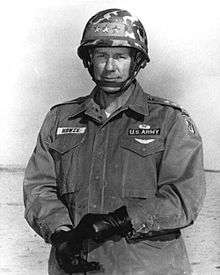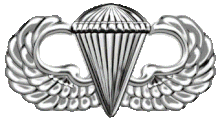Hamilton H. Howze
Hamilton Hawkins Howze (December 21, 1908 – December 8, 1998) was a general in the United States Army. He was a developer and advocate of helicopter-borne air mobility warfare.
Hamilton H. Howze | |
|---|---|
 Lt. General Hamilton H. Howze 2 April 1962 | |
| Born | December 21, 1908 West Point, New York, U.S. |
| Died | December 8, 1998 (aged 89) Fort Worth, Texas, U.S. |
| Buried | United States Military Academy Post Cemetery |
| Allegiance | United States |
| Service/ | United States Army |
| Years of service | 1930–1965 |
| Rank | General |
| Commands held | Eighth United States Army Third United States Army XVIII Airborne Corps 82d Airborne Division |
| Battles/wars | World War II |
| Awards | Army Distinguished Service Medal Silver Star Legion of Merit Bronze Star Medal |
| Relations | Major General Robert Lee Howze (father) Major General Robert Lee Howze Jr. (brother) |
Early life
Howze was born on December 21, 1908 in West Point, New York, while his father, Major General Robert Lee Howze, an 1888 West Point graduate, was serving as Commandant of the United States Military Academy.
Early career
Howze attended West Point, graduating in the Class of 1930. He was commissioned into the 6th Cavalry.[1]
In World War II Howze served as the commander of: 2nd Battalion, 13th Armor Regiment (1943); 13th Armor Regiment (1943–44); 1st Armored Division, Italy (1944–45). After the war Howze served as the G-3 of the 1st Armored Division in 1946. Three years later he attended the National War College, which was followed by an assignment in the office of the G-2 from 1949 to 1952. After promotion to brigadier general in 1952 he became Assistant Commanding General, 2nd Armored Division, European Command, until 1954.[1]
Air Mobile
Howze is recognized as the intellectual force behind the concept of air-mobility and current United States Army Aviation doctrine. While serving as the first Director of Army Aviation, Department of the Army, from 1955 to 1958, he developed new tactical principles for the employment of Army Aviation, and was instrumental in helping the Aviation Center and School become fully established in its new home at Fort Rucker, Alabama. He then became Commanding General of the 82d Airborne Division.[1]
In 1961, as Chairman of the Tactical Mobility Requirements Board, Howze led the development in airmobile theory and doctrine. The army's adoption of the recommendations in the Howze Board changed mobile warfare. Its revolutionary concepts – based on the use of aviation – changed military attitudes in a similar manner to the way the tank affected ideas on mobility 50 years earlier.[1] Two years later the 11th Air Assault Division was formed to test and validate these concepts. As a result of Howze's leadership, foresight and perception, two air-mobile divisions were eventually established. These divisions, which still adhere to the fundamentals of Howze's air-mobility doctrine, have gone on to provide mobile and combined arms capabilities that are required in today's ground combat conditions.[1]
Howze is credited with starting the convention of naming United States Army helicopter types after Native American tribes, because he found the names suggested by the manufacturers too insipid. The Bell H-13, which had already been in service for some years, was renamed "Sioux" at his suggestion and the tradition continues to the present day.[2]
Final commands
Howze served as the commander of the XVIII Airborne Corps from 1961 to 1962 and briefly acting Commanding General, Third United States Army from 1962 to 1963. In October 1962 he assumed command of the armed forces deployed to support the enrolment of James Meredith at the segregated University of Mississippi.[3]
Howze's last assignment was as Commanding General, Eighth United States Army, Commander-in-Chief of United States Forces in Korea, a four-star United Nations Command position involving United States and Republic of Korea Army troops, from 1963 to 1965.[1] General Howze retired from active duty in 1965 to Fort Worth, Texas.[1]
Retirement and legacy
Howze remained active after leaving the army and became an executive and consultant for Bell Helicopter in Fort Worth.[4] As a 1957 Charter Member of the Army Aviation Association of America (AAAA), he served for four years as the organization's Senior Vice President and President. He was also a member of the Army Aviation Hall of Fame and was the Chairman of the AAAA's Board of Trustees.[5][6]
Howze died on December 8, 1998, and was buried next to his father at the United States Military Academy Post Cemetery.[7][8]
The Howze Gunnery Award is presented by the AAAA and is sponsored by Rockwell International Corporation (in the memory of General Hamilton H. Howze), and is presented annually to the top AH-1 & AH-64 crew in the annual GEN Hamilton H. Howze Gunnery Competition. Past awardees include CW2 John S. Van Buren & 1LT Michael J. Blatz, B Company, 1st Battalion, 3rd Avn. Regiment, 2nd Armored Div., APO NY (1989), WO1 Jose E. Trejeda & CW2 John L. Kercheville, AH-1 crew, C & D Trps, 1–7 Cavalry, 1st Cav Div, Ft. Hood, TX (1991), and CW2 Jarrett R. Brewer & WO1 Kevin E. Smith, AH-64 crew, C Troop, 6th Cav Regt, Ft. Hood, TX (1991).[9]
Awards and decorations








Popular culture
General Howze was represented in a fictional account of W. E. B. Griffin's "Brotherhood of War" series of books as General "Triple H" Howard.
Notes
- Goldstein, Richard (1998-12-18). "Gen. H.H. Howze, 89, Dies; Proposed Copters as Cavalry". The New York Times. Retrieved 2009-04-12.
- Burke, Crispin (Major) (June 29, 2014). "Everyone Relax—The Army's Native American Helicopter Names Are Not Racist". medium.com. Medium Corporation. Retrieved May 29, 2015.
- Scheips, Paul (2005). The Role of Federal Military Forces in Domestic Disorders, 1945–1992 (PDF). US Army Center of Military History. p. 121. ISBN 9781517253783.

- "Gen. Hamilton Howze; Father of Air Cavalry". Los Angeles Times. December 19, 1998.
- "AAAA History". Archived from the original on 2016-03-04. Retrieved 2011-08-03.
- "Howze Gunnery Award". Archived from the original on 2016-03-04. Retrieved 2011-08-03.
- Find-a-grave.com entry
- Howze Gunnery Award
- Just Helicopters Howze biography
- Hall of Valor
- AHS Int'l Archived 2011-07-28 at the Wayback Machine
- "AAAA HoF inductees". Archived from the original on 2016-03-04. Retrieved 2011-08-03.
References
![]()
| Military offices | ||
|---|---|---|
| Preceded by John W. Bowen |
Commanding General of the 82nd Airborne Division 1958–1959 |
Succeeded by Dwight E. Beach |
| Preceded by Thomas J. H. Trapnell |
Commanding General of the XVIII Airborne Corps 1961–1962 |
Succeeded by William Westmoreland |
| Preceded by Thomas J. H. Trapnell |
Commanding General of the Third United States Army (acting) 1962–1963 |
Succeeded by Albert Watson II |
| Preceded by Bruce Palmer Jr. |
Command General of the Eighth United States Army 1963–1965 |
Succeeded by Dwight E. Beach |